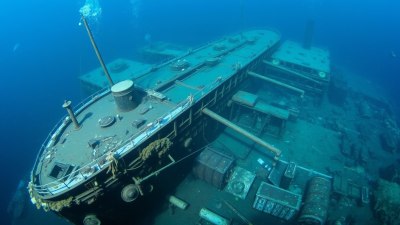Best Shipwreck Dive Sites for History and Thrill Seekers
Explore stunning shipwreck dive sites that combine history with adventure for an unforgettable experience.

Image created with Flux Schnell
Diving into shipwrecks is more than just an adrenaline rush; it is an exhilarating hunt for history frozen in time beneath the waves. Each shipwreck has its own story, filled with intrigue, adventure, and sometimes tragedy, making them ideal dive sites for history enthusiasts and thrill-seekers alike. Below, we enumerate some of the best shipwreck dive sites from around the world, showcasing the thrilling dives and rich historical narratives.
1. RMS Titanic, North Atlantic Ocean
Certainly the most famous shipwreck in the world, the RMS Titanic sank on April 15, 1912. The Titanic rests approximately 12,500 feet below the surface, and diving to this site is reserved for the most adventurous and well-funded explorers. Numerous expeditions have visited the site since its discovery, showcasing artifacts and remnants of a ship that was once a symbol of luxury and technology. Advanced submersible dives to the Titanic offer a haunting reminder of maritime history and human tragedy, making it a sought-after destination for serious divers.
2. USS Arizona, Pearl Harbor, Hawaii
The USS Arizona was sunk during the attack on Pearl Harbor on December 7, 1941, and now lies at the bottom of Pearl Harbor. It serves as a memorial to American sailors who lost their lives during World War II. Divers can explore the wreckage, which has become a haunting underwater shrine. The site is accessible for certified divers, allowing them to pay their respects while experiencing the unique biodiversity that has taken over the ruins. The wreck is in shallow water, at about 40 feet, making it accessible while still offering a poignant connection to history.
3. Thistlegorm, Red Sea, Egypt
Regarded as one of the best wreck dives in the world, the Thistlegorm was a British cargo ship sunk during World War II. The site is located in the Red Sea and lies at a depth of about 100 feet. Divers can explore a wealth of artifacts, including trucks, motorbikes, and ammunition that were intended for the war effort. The wreck itself is well-preserved and teeming with marine life, making for an unforgettable dive. Night dives at Thistlegorm can reveal even more stunning marine activity, creating an atmosphere where history and nature coexist harmoniously.
4. SS Yongala, Australia
The SS Yongala sank during a cyclone in 1911, and it is now a protected marine park teeming with marine life. Located off the coast of Queensland, the wreck lies at a depth of about 100 feet. This dive site offers divers the chance to see a vibrant underwater ecosystem, including turtles, rays, and a variety of colorful fish. The wreck itself boasts stunning coral growth, creating a living museum where history and nature intertwine. Diving the Yongala is not only a thrilling adventure but also an opportunity to observe the resilience of marine biodiversity.
5. USS Oriskany, Florida, USA
The USS Oriskany, a decommissioned aircraft carrier, was intentionally sunk in 2006 to create an artificial reef off the coast of Pensacola, Florida. The wreck lies at a depth of 140 feet and is one of the largest artificial reefs in the world. Divers can explore the vast structure, which has become a haven for a variety of marine life. The Oriskany offers an exciting mix of thrill and exploration, as divers can navigate through the ship’s interior and witness the transformation of a piece of military history into a vibrant ecosystem.
6. SS Andrea Doria, off the coast of Nantucket, USA
The SS Andrea Doria sank off the coast of Nantucket in 1956 after colliding with another ship. This dive site is known for its challenging conditions and is best suited for experienced divers. The wreck lies at a depth of about 240 feet and is often considered one of the most dangerous wreck dives due to strong currents and low visibility. However, the thrill of discovering this storied vessel, which carries remnants of its glamorous past, attracts many seasoned divers. The wreck site is also rich in marine life, making it a double whammy for those seeking both history and adventure.
7. HMAS Sydney, Australia
The HMAS Sydney was sunk during World War II, and its wreckage is one of Australia's most significant military artifacts. This site is located off the coast of Western Australia, about 2,000 meters beneath the surface. The wreck was discovered in 2008; diving to this site requires specialized equipment and experience due to its depth and conditions. Divers who take on the challenge will not only witness the remnants of a fallen warship but also leave with the profound history of sacrifice associated with the site.
8. USS Liberty, Tulamben, Bali
The USS Liberty is a sunken cargo ship that was torpedoed by a Japanese submarine in 1942. Now lying in shallow waters off the coast of Bali, the wreck is easily accessible to divers of all levels. At a depth of 70 feet, the Liberty is a hotspot for marine biodiversity and coral growth, attracting a spectrum of marine life. Divers are often mesmerized by the living reef that has formed on the wreck while being able to explore the remnants of the ship’s machinery and compartments. This site is perfect for those looking for a beautiful and history-rich dive.
9. The Zenobia, Cyprus
The MV Zenobia sank in 1980 while on its maiden voyage, making it one of the largest shipwrecks lying underwater. Located off the coast of Larnaca, Cyprus, the wreck sits at a depth of approximately 140 feet. The ship is well-preserved and boasts an array of interesting structures to explore, including lifeboats and cargo holds filled with trailers. Marine life has flourished in and around the wreck, making it a vibrant dive site. The Zenobia combines thrill with exploration, allowing divers to navigate through its remains while learning about its fascinating history.
10. U Boat Wrecks, Scapa Flow, Scotland
Scapa Flow, a natural harbor in the Orkney Islands, is home to several U-boat wrecks from World War I and II. These underwater relics provide an extraordinary view of naval history. The wrecks are located at an average depth of 60 to 100 feet, making them accessible for experienced divers. Exploring these historic submarines allows divers to step back in time and witness remnants of both naval innovation and tragedy. The site is often accompanied by rich marine life and dazzling underwater landscapes, offering divers an unforgettable experience.
Exploring shipwrecks brings to light the stories of the past while providing an exhilarating adventure. The allure of these dive sites lies in their ability to transport divers into a world where history and nature collide dramatically. Whether you are a history buff or an adrenaline junkie, these wrecks offer a fantastic opportunity to explore the depths of oceans while connecting with an important part of our collective history. Each dive is not just about the thrill; it's a journey into the unknown where you can witness how time transforms human endeavors into coral-covered ruins, teeming with life and history waiting to be discovered.











